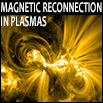Speaker
Dr
Huishan Fu
(Beihang University)
Description
In this study, we apply a new method—the first-order Taylor expansion
(FOTE)—to
find magnetic nulls and reconstruct magnetic field topology, in order to
use it with
the data from the forth-coming MMS mission. We compare this method
with the
previously used Poincare index (PI), and find that they are generally
consistent,
except that the PI method can only find a null inside the spacecraft
(SC)
tetrahedron, while the FOTE method can find a null both inside and
outside the
tetrahedron and also deduce its drift velocity. In addition, the FOTE
method can (1)
avoid limitations of the PI method such as data resolution, instrument
uncertainty
(Bz offset), and SC separation; (2) identify 3D null types (A, B, As, and
Bs) and
determine whether these types can degenerate into 2D (X and O); (3)
reconstruct
the magnetic field topology. We quantitively test the accuracy of FOTE
in positioning
magnetic nulls and reconstructing field topology, by using the data
from 3D kinetic
simulations. The influences of SC separation (0.05~1 di) and null-SC
distance (0~1
di) on the accuracy are both considered. We find that: (1) for an
isolated null, the
method is accurate when the SC separation is smaller than 1 di, and
the null-SC
distance is smaller than 0.25~0.5 di; (2) for a null pair, the accuracy is
same as in
the isolated-null situation, except at the separator line, where the field
is nonlinear.
We define a parameter in terms of the eigenvalues of the null to
quantify the
quality of our method—the smaller this parameter the better the
results. Comparing
to the previously used one, this parameter is more relevant for null
identification.
Using the new method, we reconstruct the magnetic field topology
around a radial-
type null and a spiral-type null, and find that the topologies are well
consistent with
those predicted in theory. We therefore suggest using this method to
find magnetic
nulls and reconstruct field topology with four-point measurements,
particularly from
Cluster and the forth-coming MMS mission. For the MMS mission, this
null-finding
algorithm can be used to trigger its burst-mode measurements.
Author
Dr
Huishan Fu
(Beihang University)
Co-authors
Dr
Alessandro Retino
(Laboratoire de Physique des Plasmas)
Dr
Andris Vaivads
(Swedish Institute of Space Physics)
Dr
Giovanni Lapenta
(KU Leuven)
Dr
Jinbin Cao
(Beihang University)
Dr
Mats André
(Swedish Institute of Space Physics)
Dr
Shiyong Huang
(Wuhan University)
Dr
Vyacheslav Olshevsky
(KU Leuven)
Dr
Yuri Khotyaintsev
(Swedish Institute of Space Physics)

